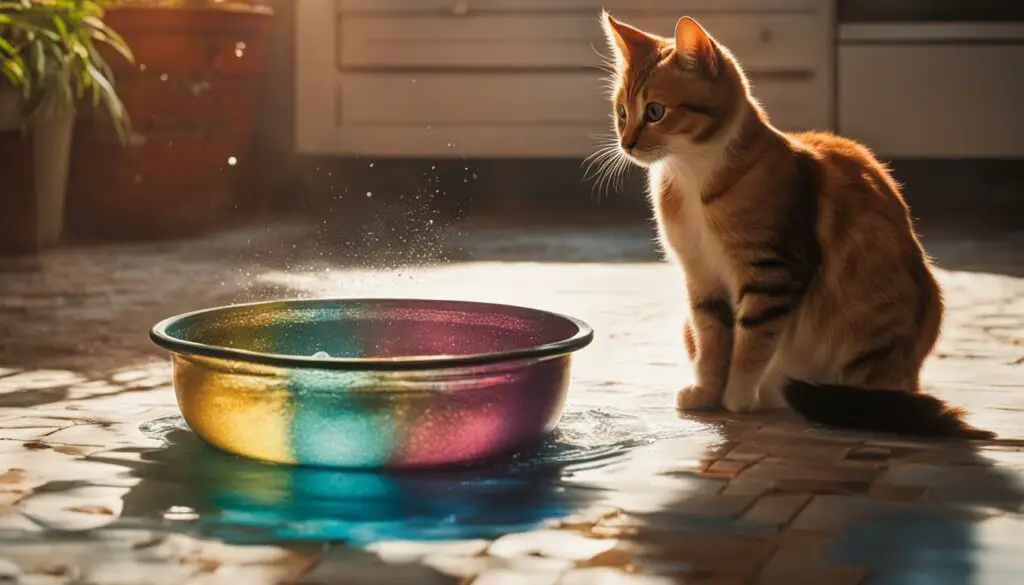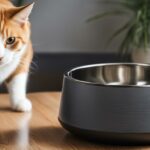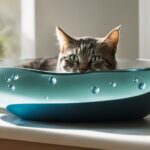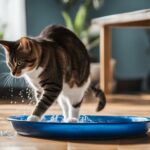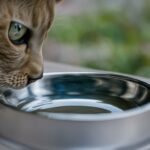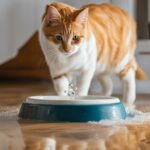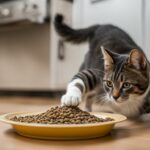Are you tired of constantly cleaning up spills from your cat’s water bowl? Do you want to find effective ways to prevent water spillage and ensure your furry friend stays hydrated? Look no further! In this article, I will provide you with insightful perspectives on how to stop your cat from spilling their water bowl.
Key Takeaways:
- Understanding your cat’s behavior is crucial in preventing water spillage.
- Cats may spill water from their bowls due to playfulness, dislike of the bowl, or a preference for running water.
- Strategies such as using no-spill water bowls, providing alternative toys, and keeping water fresh and clean can help mitigate spills.
- Changing the location of the water bowl and implementing behavior modification techniques can also be effective in preventing spills.
- Maintaining optimal pet care includes ensuring access to fresh water and clean bowls for your cat.
Cats Tipping Over Water Bowls
One common behavior that many pet owners encounter is cats tipping over their water bowls. This can lead to water spillage, frustration, and potential damage to the surrounding area. To address this issue, there are several spill prevention techniques that pet owners can employ.
- Use no-spill water bowls: These bowls are designed with a weighted or anti-tip base, making it difficult for cats to knock them over.
- Provide an alternative water source: Leaving a tap in the bathroom running at a slow drip allows cats to drink from the sink, reducing their desire to tip over their water bowl.
It’s essential for pet owners to find a solution that works best for their cat’s behavior. Some cats may prefer a specific type of bowl or enjoy drinking from a running water source. By understanding their cat’s preferences and utilizing appropriate spill prevention techniques, pet owners can help create a spill-free environment and ensure their cats have access to water whenever they need it.
“Using a no-spill water bowl has been a game-changer for my cat. She used to enjoy tipping her water bowl over, but the weighted base of the no-spill bowl has made it impossible for her. Now, I don’t have to worry about water spills and can focus on keeping my cat hydrated.
– Cat Owner
Table: Comparison of Spill Prevention Techniques
| Technique | Pros | Cons |
|---|---|---|
| No-Spill Water Bowls | – Weighted or anti-tip base prevents tipping – Wide range of options available |
– Some cats may still find a way to tip over – Requires regular cleaning and maintenance |
| Running Tap as Alternative | – Provides cats with access to running water – Reduces the desire to tip over water bowl |
– May result in increased water consumption – Requires careful monitoring of water usage |
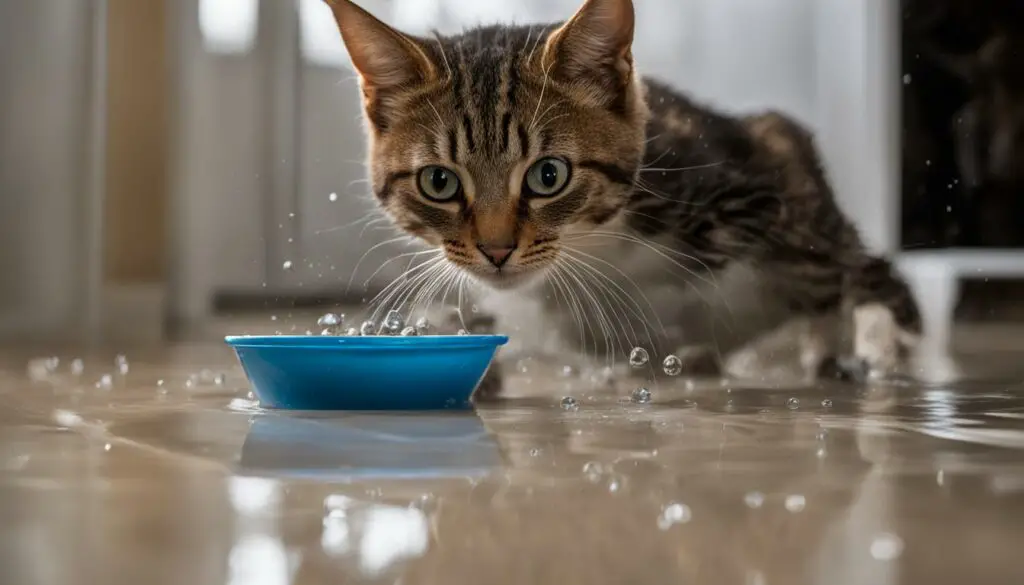
Overall, cats tipping over water bowls is a common issue that can be addressed with the right spill prevention techniques. By choosing the appropriate water bowl and providing alternative water sources, pet owners can ensure their cats remain hydrated without the hassle of constant water spills.
Cats Playing in Water Bowls
Cats playing in their water bowls can often result in spills and wet floors. This behavior is more common in kittens but can persist into adulthood. To prevent water spills, there are several behavior modification techniques and spill management strategies that pet owners can implement.
One effective approach is to provide alternative toys and activities to keep cats entertained and distracted from the water bowl. Interactive toys, such as puzzle feeders or treat-dispensing toys, can keep cats engaged and redirected away from the water bowl. Additionally, setting up a designated play area with scratching posts, climbing trees, and interactive wand toys can help satisfy their play instincts and reduce their interest in the water bowl.
Another spill reduction technique is the use of no-spill bowls. These bowls are designed with special features such as raised edges or floating disks that prevent cats from splashing or tipping the water out. They can be an effective solution for cats who are particularly playful or curious around their water bowls.
| Behavior Modification Techniques | Spill Management Strategies |
|---|---|
| Provide alternative toys and activities | Use no-spill bowls |
| Set up a designated play area | Place a waterproof mat under the water bowl |
| Redirect attention with interactive toys | Consider using a cat water fountain |
It’s important to note that every cat is unique, and not all strategies may work for every cat. It may require some trial and error to find the most effective spill management techniques for your feline companion. Consulting with a veterinarian or animal behaviorist can also provide valuable insight and guidance.
Cats Pawing at Water Bowls
One common behavior that can lead to water spills is when cats paw at their water bowls. This behavior may occur for various reasons, such as dislike of the bowl or as a way of cleaning their paws. To prevent water spills and manage this behavior, here are some tips:
Spill Prevention Tips
- Try different types of water bowls: Some cats may prefer different materials or shapes, so experimenting with various bowls can help reduce pawing behavior.
- Use a waterproof pet food mat: Placing a waterproof mat under the water bowl can help contain any spills and protect the floor.
Cat Training:
“Training cats to avoid pawing at their water bowls can be challenging, but not impossible. Using positive reinforcement techniques, such as rewarding cats with treats or praise when they drink without pawing, can help modify their behavior over time.
It’s important to remember that each cat is unique, so what works for one may not work for another. Consistency, patience, and observing your cat’s preferences and behavior can help you find the most effective strategies to prevent water spills caused by pawing.

Table: Comparison of Water Bowl Types
| Type of Water Bowl | Pros | Cons |
|---|---|---|
| No-spill bowl | Prevents spills and reduces the likelihood of pawing behavior | May not be suitable for all cats, can be more expensive |
| Elevated bowl | Can discourage pawing and improve posture for cats with joint issues | May not be preferred by all cats, can take time for adjustment |
| Wide shallow bowl | Allows cats to drink without touching the water with their paws | May be prone to spills if the cat accidentally splashes water with their chin |
By understanding your cat’s behavior and preferences, trying different strategies, and providing appropriate training, you can help prevent water spills caused by pawing and create a spill-free environment for your furry friend.
Cats Flicking Water out of Bowls
When it comes to cats flicking water out of their bowls, understanding their behavior and implementing appropriate spill prevention approaches is key. This behavior can be attributed to a variety of factors, including a preference for running water or a way to gauge the water level. By taking steps to address these underlying reasons, cat owners can minimize water spills and maintain a clean living environment for their feline companions.
Cat psychology insights reveal that some cats may flick water out of their bowls as a way to mimic the movement of running water, which they often find more appealing. To cater to this preference, pet owners can consider incorporating a cat water fountain into their homes. These fountains provide a constant flow of water, eliminating the need for cats to dip their paws into their bowls and reducing the chances of spills.
Additionally, selecting the right type of water bowl can also help prevent water flicking behavior. Non-slip bowls with higher edges can make it more difficult for cats to flick water out while drinking. Cat owners can also place a waterproof mat beneath the bowl to catch any splashes and minimize the cleanup required. By considering these spill prevention strategies, cat owners can better manage water spills caused by flicking behavior.
| Spill Prevention Approaches | Benefits |
|---|---|
| Using a cat water fountain | Provides a constant flow of water, reducing the need for cats to flick water out of their bowls |
| Choosing non-slip bowls with higher edges | Makes it more difficult for cats to flick water out while drinking |
| Placing a waterproof mat beneath the bowl | Catches any splashes, minimizing cleanup |
By understanding the underlying reasons behind cats flicking water out of their bowls and implementing suitable spill prevention approaches, pet owners can create a more harmonious environment and ensure their furry friends stay hydrated without causing unnecessary water spills.
Understanding the Reasons behind Water Spillage
When it comes to cats spilling water from their bowls, there are several underlying reasons for this behavior. Understanding these reasons can help pet owners effectively prevent water spillage and create a more harmonious environment for their feline companions. Let’s take a closer look at some of these reasons:
Instinctual Behavior
Cats have natural instincts that drive their behaviors, and spilling water may be a result of these innate tendencies. For example, a cat’s predatory instincts may cause them to paw at the water in an attempt to test the depth or simulate hunting behavior. By recognizing and acknowledging these instincts, pet owners can use behavior training techniques to redirect their cat’s behavior and minimize water spillage.
Dislike for the Water Bowl
Sometimes, cats may simply dislike their water bowl, leading them to engage in behaviors that result in spills. This could be due to the size, shape, or material of the bowl. To address this issue, pet owners can experiment with different types of bowls, such as wider and shallower options or bowls made from a different material. Finding a water bowl that suits the cat’s preferences can significantly reduce spillage.
Preference for Running Water
Many cats have a natural preference for running water due to their ancestral instincts, which associate flowing water with freshness. This can lead cats to flick water out of their bowls as they try to create movement or seek out a more appealing water source. Providing a cat water fountain with a constant flow of water can cater to their preference for running water and help prevent spills.
| Reasons for Water Spillage | Prevention Techniques |
|---|---|
| Instinctual Behavior | Behavior training to redirect behavior |
| Dislike for the Water Bowl | Experiment with different bowl types |
| Preference for Running Water | Provide a cat water fountain |
By understanding the reasons behind water spillage, pet owners can implement appropriate spill prevention techniques and effectively communicate with their cats. Building a trusting relationship and using behavior training methods can help address underlying issues and promote positive behaviors around the water bowl.
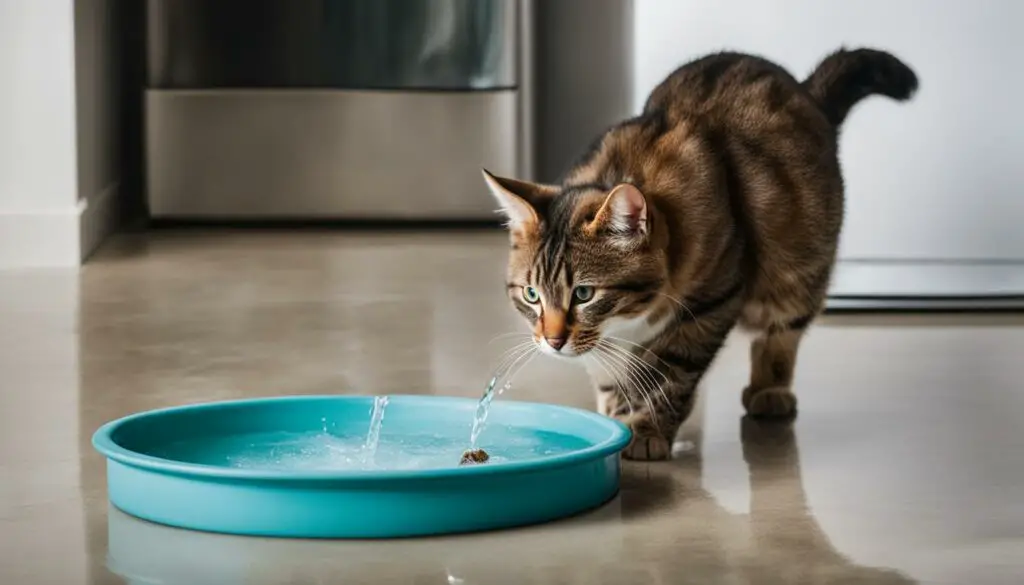
Communication with Cats
Communication plays a vital role in understanding and addressing cat behavior. By observing their cats closely and interpreting their body language, vocalizations, and overall demeanor, pet owners can gain valuable insights into their feline companions. This allows for better communication and a deeper understanding of their needs and preferences, including those related to water spillage.
Behavior training is also an essential aspect of communication with cats. Positive reinforcement techniques can be used to teach and reward desired behaviors, while redirection techniques can help shift their focus away from water spillage and towards more appropriate activities. By effectively communicating with their cats and providing the necessary training, pet owners can minimize water spillage and foster a happier, healthier relationship with their feline companions.
Preventing Water Bowl Tipping
When it comes to preventing cats from tipping over their water bowls, there are various strategies that can be implemented to ensure spill control and promote a cleaner living environment. Understanding feline instincts and preferences is key to finding effective spill prevention methods.
One method is to use weighted or non-slip bowls that are difficult for cats to knock over. These bowls are designed with stability in mind, making it harder for cats to tip the entire bowl and cause spills. Another option is to use elevated stands, which can help prevent tipping by raising the bowl off the ground and providing added stability.
In addition, considering the location of the water bowl can play a significant role in spill prevention. Placing the bowl in a location that is less prone to spills, such as a corner or against a wall, can minimize the likelihood of cats bumping into it and causing spills.
Table: Comparing Different Spill Prevention Methods
| Spill Prevention Method | Description |
|---|---|
| Weighted or non-slip bowls | Bowls designed to be difficult to tip over |
| Elevated stands | Raise the bowl off the ground for added stability |
| Strategic placement | Placing the bowl in a location that is less prone to spills |
“By utilizing these spill prevention methods, pet owners can create a spill-free environment and ensure their cats have access to drinkable water throughout the day.”
It’s important to remember that cats may have their own unique preferences and behaviors, so it may take some trial and error to find the most effective method for your cat. By combining different spill prevention techniques and considering your cat’s individual needs, you can help minimize water spills and provide a safe and hygienic drinking experience for your furry friend.
Managing Water Bowl Playfulness
When it comes to cats and their water bowls, playfulness can often lead to spills and a messy living environment. Fortunately, there are several effective strategies for managing water bowl playfulness and minimizing the risk of spills. By implementing these spill mitigation techniques and utilizing pet training methods, you can create a harmonious environment where your cat can play and drink without causing water spills.
To start, consider using no-spill bowls that are specifically designed to prevent water from splashing or tipping out. These bowls typically have an innovative design that keeps the water contained, even when your cat becomes playful or curious. Additionally, providing alternative toys and activities can help redirect your cat’s attention away from the water bowl. Interactive toys, puzzle feeders, and climbing structures can keep your cat engaged and entertained, reducing their interest in playing with the water.
Another effective spill containment strategy is to create a designated play area for your cat away from the water bowl. This can be achieved by setting up a separate play zone with toys, scratching posts, and other enrichment activities. By providing a specific area for play, your cat will be less likely to engage in water bowl playfulness and more focused on their designated play area.
| Managing Water Bowl Playfulness | Spill Mitigation Strategies |
|---|---|
| Use no-spill bowls | Prevent water splashing or tipping out |
| Provide alternative toys and activities | Redirect your cat’s attention away from the water bowl |
| Create a designated play area | Separate play zone with toys and enrichment activities |
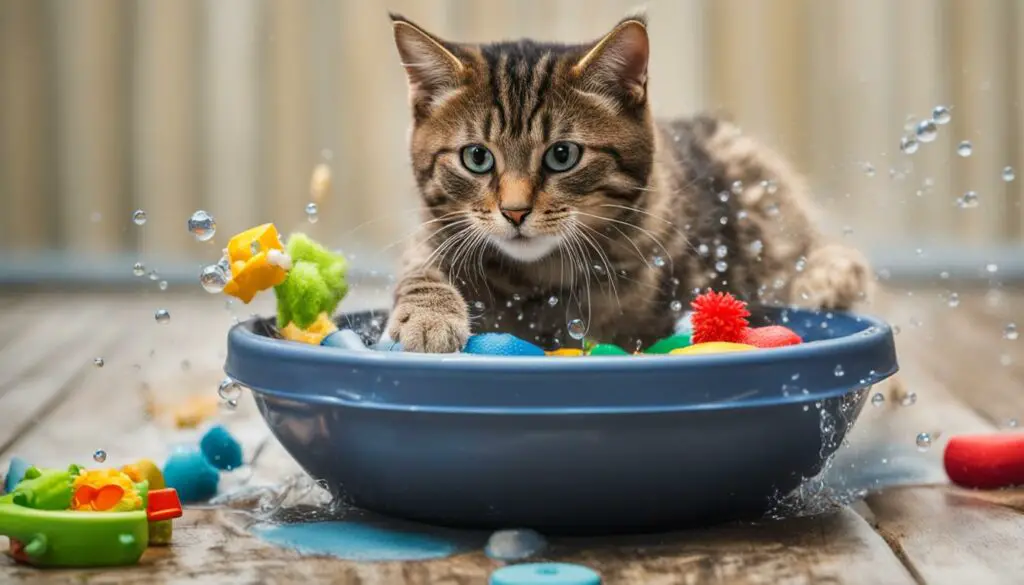
By implementing these spill containment strategies and catering to your cat’s need for play and stimulation, you can effectively manage water bowl playfulness. Remember to observe your cat’s behavior and adjust your approach as needed. With a little bit of training and the right tools, you can create a spill-free environment and ensure your cat stays hydrated while enjoying their playtime.
Addressing Pawing Behavior
Understanding and addressing pawing behavior in cats is crucial for spillage management and maintaining a harmonious living environment. Cats may paw at their water bowls before drinking due to a variety of reasons, including discomfort with the bowl or a desire to clean their paws. By implementing a few strategies, you can effectively reduce water spillage caused by pawing behavior.
Understanding Feline Behavior
In order to address pawing behavior in cats, it is important to have a deeper understanding of feline behavior. Cats have unique preferences and instincts that influence their actions. Some cats may prefer certain types of water bowls or have a natural inclination to clean their paws before drinking. By recognizing these behaviors as normal feline tendencies, you can approach them with patience and find suitable solutions.
One approach to addressing pawing behavior is to try different types of water bowls. Some cats may have a preference for wider, shallow bowls or raised water bowls as they provide a more comfortable drinking experience. Additionally, using a waterproof mat under the water bowl can protect your floors from spills and make cleaning up easier.
Providing a raised water bowl or wider shallow bowl can help alleviate the pawing behavior in some cats.
Ultimately, understanding your cat’s individual preferences and behavior patterns will help you determine the most effective solution for addressing pawing behavior and preventing water spillage.
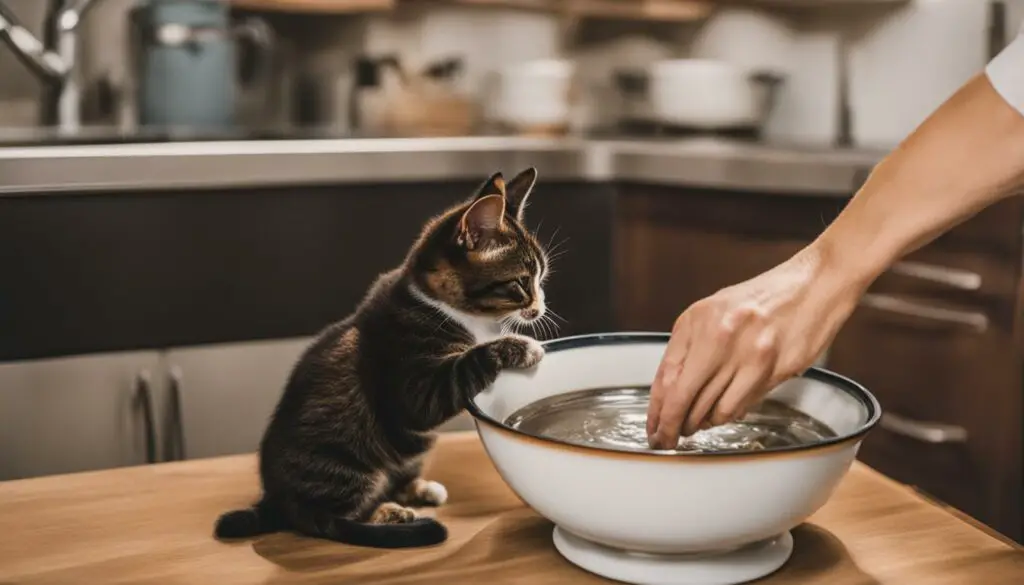
| Methods | Advantages | Disadvantages |
|---|---|---|
| Try different types of water bowls | – Provides options to cater to your cat’s preferences – Can reduce discomfort and encourage proper drinking behavior |
– May require trial and error to find the most suitable bowl – Some cats may still exhibit pawing behavior despite changing the bowl |
| Use a waterproof mat | – Protects floors from water spills – Easy to clean |
– May not completely eliminate pawing behavior – Requires regular maintenance to keep the mat clean |
By addressing pawing behavior and implementing suitable solutions, you can effectively manage water spillage from your cat’s water bowl. Remember to observe your cat’s behavior, provide a comfortable drinking environment, and be patient during the training process. With time and consistency, you can help your cat develop healthier drinking habits and maintain a spill-free living space.
Dealing with Water Flicking
When it comes to cats and water bowls, one common behavior that pet owners may encounter is water flicking. This behavior occurs when cats dip their paws into the water bowl and flick water out before drinking. To prevent spills and maintain a clean living environment, there are several spill containment and prevention strategies that can be implemented.
One effective solution is to provide cats with a cat water fountain. These fountains provide a constant source of running water, eliminating the need for cats to stick their paws in the water and reducing the dirtiness of the water between refills. The constant flow of water also appeals to cats’ preference for running water, making the fountain a practical and attractive option.
Another approach is to establish clear communication with cats. By redirecting their attention and behavior, pet owners can minimize water flicking. Providing alternative toys and activities that engage cats’ curiosity and energy can help distract them from the water bowl and reduce the frequency of water flicking incidents.
Spill Containment and Prevention Strategies for Water Flicking
When it comes to water flicking, spill containment and prevention strategies play a crucial role. Here are some effective techniques:
- Use a cat water fountain to provide a constant source of running water.
- Place a waterproof mat underneath the water bowl to catch any flicked water.
- Provide alternative toys and activities to keep cats engaged and distracted.
- Ensure the water bowl is wide and shallow to minimize the amount of water that can be flicked out.
By implementing these strategies and understanding the reasons behind water flicking behavior, pet owners can create a spill-free environment for their cats while maintaining their hydration needs.
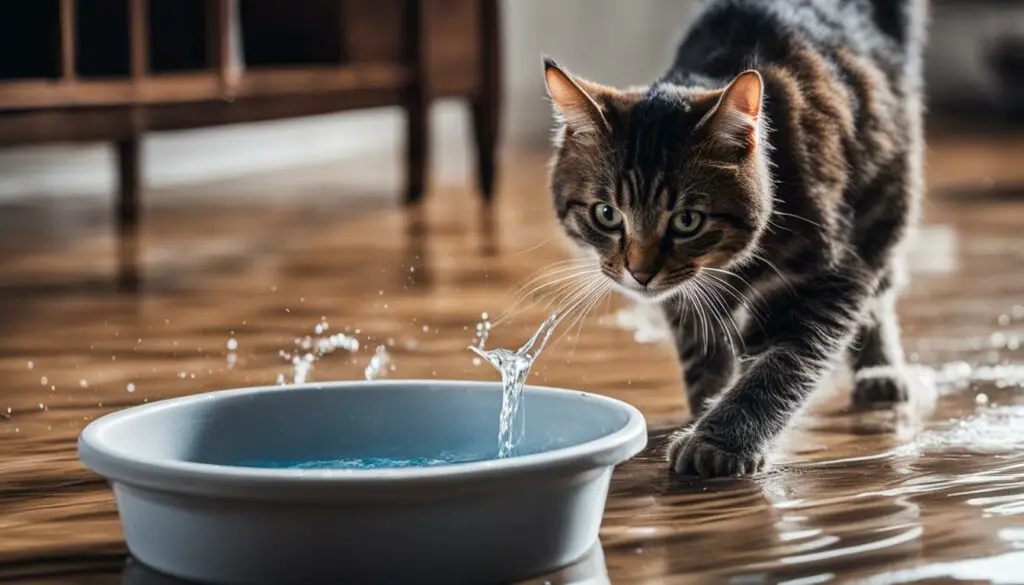
The Overlapping Reasons behind Water Spillage
When it comes to understanding why cats spill water from their bowls, there are several overlapping reasons that pet owners should consider. Cats may engage in multiple behaviors such as tipping over the bowl, playing in the water, pawing at the bowl, or flicking water out. These behaviors can be triggered by various factors like playfulness, dislike for the water bowl, or a preference for running water.
To effectively prevent water spillage, a combination of spill prevention techniques and behavior modification techniques can be used. Pet owners can start by providing weighted or non-slip bowls that are difficult for cats to knock over. Additionally, using no-spill bowls or providing alternative water sources like a cat water fountain can help redirect their behavior and minimize spills.
Understanding the underlying reasons for water spillage is key to implementing the right strategies. It’s important to observe your cat’s behavior and preferences to tailor the approach accordingly. By utilizing a combination of spill prevention techniques and behavior modification techniques, pet owners can create a spill-free environment and ensure their feline friends stay hydrated.
Table: Techniques for Preventing Water Spillage
| Technique | Explanation |
|---|---|
| Weighted or non-slip bowls | Make it difficult for cats to tip over the bowl. |
| No-spill bowls | Prevent water from splashing or spilling out of the bowl. |
| Cat water fountain | Provide a constant flow of running water to satisfy their preference. |
| Observing behavior | Monitor your cat’s behavior to determine the underlying reasons for water spillage. |
| Behavior modification | Implement training techniques to redirect their behavior and preferences. |
Understanding Why Cats Knock Things Over
When it comes to cat behavior, one common yet perplexing habit is their tendency to knock things over. Whether it’s a vase on a shelf or a stack of papers on a desk, cats seem to take delight in toppling objects. As a cat owner, it’s important to understand the reasons behind this behavior and explore behavior modification techniques to curb this destructive habit.
One reason why cats knock things over is rooted in their natural instincts as predators. Cats have an innate curiosity and a desire to explore their surroundings. Knocking objects over allows them to engage their hunting instincts, as they watch the objects fall and scatter, mimicking the capture of prey. This behavior can also be a way for cats to seek attention or communicate their boredom, especially when they lack stimulation or interactive toys to keep them engaged.
To modify this behavior, owners can implement several strategies. Providing enrichment activities, such as interactive toys and scratching posts, can redirect their attention and energy towards more appropriate outlets. Additionally, creating vertical spaces with shelves or cat trees allows cats to climb and explore, channeling their natural instincts in a constructive manner. By understanding the motivations behind this behavior and addressing them through environmental enrichment and play, owners can effectively reduce the frequency of objects being knocked over.
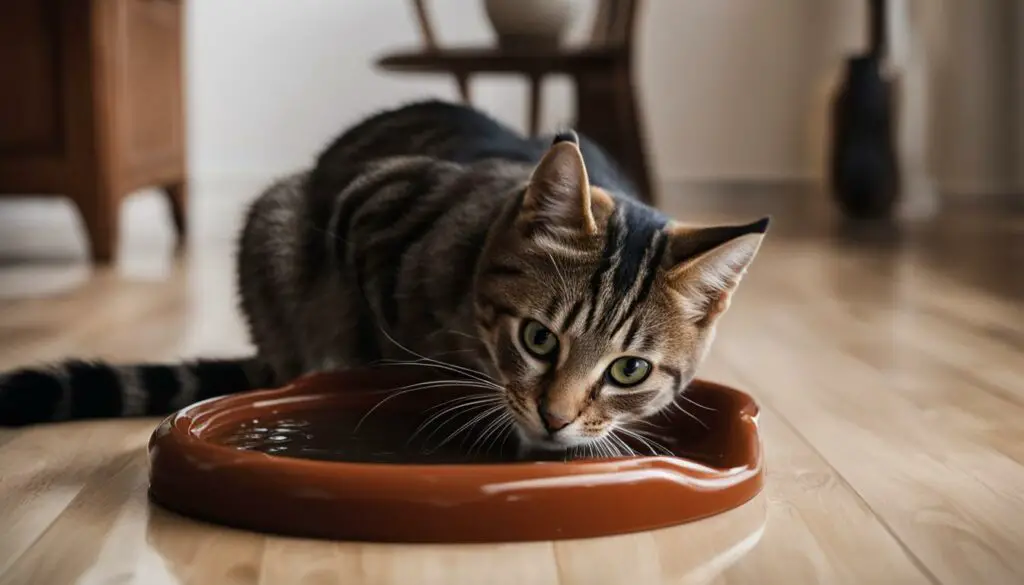
In conclusion, understanding why cats knock things over is the first step in modifying this behavior. By acknowledging their instincts as predators and implementing behavior modification techniques, such as providing enrichment activities and vertical spaces, owners can help redirect their cats’ energy and prevent damage to household items. Remember, patience and consistency are key when it comes to modifying any behavior, and with time, your furry friend will learn more appropriate ways to expend their energy.
Preventing Cats from Knocking Things Over
When it comes to preventing cats from knocking things over, effective environmental management and enrichment activities are key. By creating a cat-friendly environment and providing engaging alternatives, pet owners can minimize destructive behaviors and maintain a harmonious living space.
One effective strategy for preventing cats from knocking things over is to manage the environment. This involves placing breakable or valuable items out of reach, securing them in cabinets or on shelves. By removing the temptation, cats are less likely to engage in destructive behavior. Additionally, providing designated areas for climbing and scratching, such as scratching posts and cat trees, can redirect their energy towards more appropriate outlets.
Enrichment activities play a crucial role in keeping cats mentally stimulated and physically active, reducing the likelihood of destructive behavior. Interactive toys, puzzles, and treat-dispensing devices can provide mental challenges and entertainment. Regular play sessions with interactive toys, such as feather wands or laser pointers, can help burn off excess energy and prevent boredom.
Creating a cat-friendly environment and providing engaging alternatives can help prevent cats from knocking things over.
In summary, preventing cats from knocking things over requires a combination of environmental management and enrichment activities. By creating a cat-friendly environment, securing valuable items, and providing plenty of mental and physical stimulation, pet owners can help their feline friends channel their energy in a positive way. This not only protects household items but also promotes a happy and fulfilled cat.

Table: Comparison of Environmental Management and Enrichment Activities
| Environmental Management | Enrichment Activities |
|---|---|
| Secure breakable items | Provide interactive toys |
| Remove access to valuable items | Use treat-dispensing devices |
| Invest in scratchers and climbing structures | Engage in regular play sessions |
Providing Fresh Water and Clean Bowls
Ensuring that your furry friend has access to fresh water in clean bowls is essential for their overall health and well-being. Cats are known to be picky about their water source, and providing them with clean water can help prevent dehydration and promote hydration. Here are some key tips for providing fresh water and clean bowls for your feline companion.
1. Cleaning the Water Bowl: It is important to clean your cat’s water bowl daily to remove any bacteria or residue that may accumulate. Washing the bowl with mild soap and warm water and rinsing it thoroughly will help maintain sanitary conditions for your pet’s drinking water. This simple step ensures that your cat is not exposed to harmful contaminants.
2. Refilling with Fresh Water: In addition to regular cleaning, it is crucial to refill the water bowl with fresh water daily. Cats prefer clean, cool water, and stagnant water may discourage them from drinking enough. By replenishing the water bowl with fresh water, you can encourage your cat to stay hydrated and prevent water spillage caused by cats seeking alternative water sources.
3. Multiple Water Bowls: Placing multiple water bowls around your home can provide convenient access to fresh water for your cat. This is particularly beneficial if you have a multi-level house or if your cat spends time in different areas. Having water bowls readily available in various locations ensures that your cat is never far from a hydration source, reducing the risk of water spills caused by cats searching for water elsewhere.
| Benefits of Providing Fresh Water and Clean Bowls |
|---|
| Promotes hydration and prevents dehydration |
| Reduces the risk of bacterial contamination |
| Encourages cats to drink more water |
| Minimizes the chances of cats seeking unsuitable water sources |
By prioritizing fresh water and clean bowls for your cat, you are taking an important step in ensuring their well-being. Regular cleaning and refilling, along with the provision of multiple water bowls, can help prevent water spillage and make drinking a hassle-free experience for your feline companion. Remember, a happy and hydrated cat is a healthy cat!

Changing the Water Bowl Location
When it comes to preventing water spills from cat water bowls, changing the location of the bowl can be an effective strategy. By understanding your cat’s behavior and preferences, you can find an ideal location that is less prone to spills. Here are some tips for changing the water bowl location:
1. Observe your cat’s behavior:
Take note of where your cat spends most of their time and where they naturally gravitate towards when they are thirsty. This can give you an indication of the preferred areas to place the water bowl.
2. Provide multiple water bowl options:
Consider placing water bowls in different areas of your home or yard to give your cat options. This can help reduce the likelihood of spills if one bowl gets knocked over, and also ensure that your cat has access to water at all times.
3. Use spill-proof water bowl alternatives:
If you are unable to find a location that is completely spill-free, consider using spill-proof water bowl alternatives. These bowls are designed to minimize spills and keep the water contained, even if they are accidentally tipped over.
By changing the water bowl location and implementing these tips, you can reduce the risk of water spills and ensure that your cat stays hydrated. Remember to observe your cat’s behavior and preferences to find the most suitable location for their water bowl.
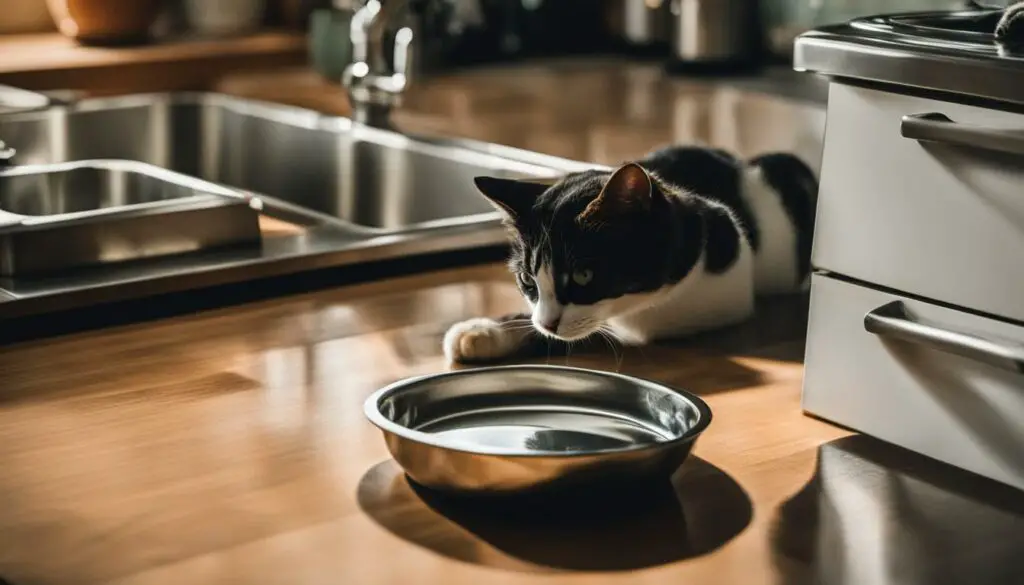
Conclusion
Understanding cat behavior and implementing effective spill prevention strategies is crucial for pet care and maintaining a peaceful living environment. Cats may engage in various behaviors that result in water spillage from their bowls, such as tipping over the bowl, playing in the water, pawing at the bowl, or flicking water out. By addressing the underlying reasons for these behaviors, pet owners can minimize water spills and ensure their feline companions stay hydrated.
To prevent water bowl tipping, pet owners can use weighted or non-slip bowls and elevated stands to make it harder for cats to knock them over. Providing no-spill bowls or leaving a running tap in the bathroom can also prevent spills caused by playfulness or a preference for running water. Likewise, offering alternative toys and activities can distract cats from playing in their water bowls, reducing the likelihood of spills and wet floors.
Addressing pawing behavior can be achieved by using different types of water bowls or using a waterproof pet food mat to protect the floor. For cats that flick water out of their bowls, a cat water fountain can provide a constant flow of water, eliminating the need for cats to use their paws and reducing spills. Additionally, maintaining a clean bowl and changing its location can further minimize water spillage from cat water bowls.
By implementing a combination of spill prevention techniques and behavior modification strategies, pet owners can create a spill-free environment that ensures their cats have access to fresh water and stay hydrated. Understanding cat behavior and their reasons for water spillage is key to providing optimal pet care and promoting the well-being of our feline companions.
FAQ
How can I prevent my cat from tipping over their water bowl?
You can use weighted or non-slip bowls that are difficult to knock over. Elevated stands can also be used to make it harder for cats to tip the entire bowl.
What can I do if my cat plays in their water bowl?
You can use no-spill bowls or provide alternative toys and activities to keep them entertained and distracted from the water bowl.
Why does my cat paw at their water bowl?
Cats may paw at their water bowls due to a dislike for the bowl or as a way of cleaning their paws. You can try different types of water bowls or use a waterproof pet food mat to protect the floor.
What should I do if my cat flicks water out of their bowl?
You can use a cat water fountain, which provides a constant flow of water and prevents the need for cats to stick their paws in the bowl. This reduces water spillage and keeps it cleaner between refills.
Why do cats engage in behaviors that result in water spillage?
Cats may engage in these behaviors due to their instincts, playfulness, or a dislike for the water bowl. Understanding the reasons behind the behavior can help you implement effective strategies to prevent spills.
How can I stop my cat from knocking things over?
You can place breakable items out of reach and provide enrichment activities such as scratching posts and toys to keep them entertained and reduce their desire to engage in destructive behaviors.
How can I ensure my cat stays hydrated and their water bowl doesn’t spill?
Clean your cat’s water bowl daily and ensure it is filled with fresh water. You can also consider using no-spill bowls or a cat water fountain to prevent spills. Changing the location of the water bowl may also help.
How can I change the location of the water bowl to prevent spills?
Experiment with different areas of the house or yard to find a location that is less prone to spills. Understanding your cat’s preferences and patterns can help you find the ideal location.
Why is it important to understand cat behavior and implement appropriate strategies?
Understanding cat behavior helps in preventing water spills from cat water bowls. By implementing effective strategies, you can create a spill-free environment and ensure your cat stays hydrated.

